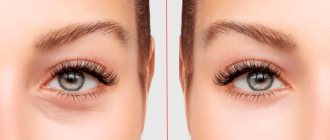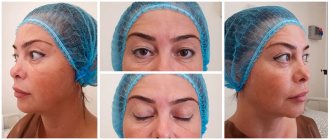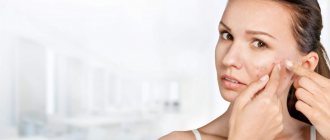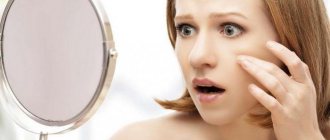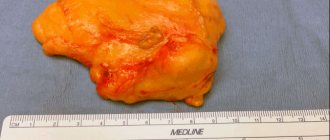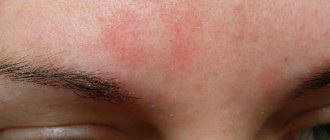Blepharitis is an eye disease in which the eyelids become very swollen and red. Each type of blepharitis has its own characteristic symptoms. Treatment can take from two weeks to two months, so it is important to contact a specialist in time to prevent complications. We will tell you in the article how different types of this pathology are treated.
In this article
- Signs of blepharitis
- What causes the development of blepharitis of the eyelids?
- What types of blepharitis are there?
- Treatment of blepharitis
- Rules for the use of drugs
- Physiotherapy for the treatment of blepharitis
- What additional measures should be taken when treating blepharitis?
- What are the consequences of untimely treatment?
Blepharitis usually affects the upper and lower eyelids. After diagnosis, the doctor will determine the cause of the disease - based on this, effective medications are prescribed. Too long a course of the disease can lead to unpleasant complications: the appearance of chalazion, barley, the development of keratitis or conjunctivitis, and also deteriorate the quality of vision. When the first symptoms of blepharitis appear, you should immediately begin treatment. How to recognize them?
What is blepharitis?
In this article
- What is blepharitis?
- Signs of the upper eyelid
- Why does blepharitis of the upper eyelid develop?
- Diagnosis of the disease
- What is the difficulty in diagnosing blepharitis of the upper eyelid?
- What types of blepharitis affect the upper eyelid?
- What is local therapy?
- Methods of etiological treatment
- Principles of restorative therapy
- Hygiene procedures for blepharitis of the upper eyelid
- Treatment with folk remedies
- Blepharitis of the upper eyelid. Treatment prognosis
Blepharitis is the Latin name for a very wide group of ophthalmological diseases. They have different symptoms, inflammations can form in different places. In most cases, blepharitis affects the edges of the eyelid. This can happen both from the outside and from the inside. Often the inflammatory process affects the meibomian glands. There are quite a few types of disease. They all differ in different pathogens, but are accompanied by largely similar symptoms.
The difficulty with blepharitis is that this disease is difficult to treat. The localization of the inflammatory process almost always develops in the ciliary edges of the eyelids. The disease has a tendency to relapse. It can last for a very long time and, as a result, become chronic. Blepharitis is quite difficult for the patient to tolerate. The disease leads to decreased performance and can often lead to decreased and even loss of vision. If discomfort occurs, it is necessary to find out the source of the discomfort and seek help from an ophthalmologist.
Using low quality cosmetics
Cosmetics do not always contain safe ingredients - some products are made with the addition of harmful substances. They help maintain the criteria for color consistency (make it resistant to water and moisture), but are not always compatible with the skin.
Even a single use of low-quality products is enough to cause peeling and itching of the tissues surrounding the eyes.
Also, crusts and conditions where the eyelids itch occur due to the use of expired cosmetics or products that have previously been used by another person. For this reason, it is highly undesirable to use testers that are offered in mass markets.
Hypovitaminosis
A lack of vitamin A (retinol) in the body causes the eyelids to itch, hurt, peel, and turn red. Other signs of hypovitaminosis are conjunctivitis, slow wound healing, brittle nails, hair loss, blurred vision, reduced immunity and susceptibility to infectious diseases.
The main causes of hypovitaminosis are insufficient intake of this substance from the diet (for example, due to constant cooking of foods), diseases of the gastrointestinal tract, in which the substance is not absorbed. Retinol is found in meat, fish, and seafood, and it is with diet correction that the process of eliminating hypovitaminosis must begin.
Choose a specialist, read reviews and make an appointment with a therapist online
Demodicosis
The disease is caused by mites of the genus Demodex. They get onto the skin of the eyelids from Vaseline, creams, vegetable oil, and feather pillows. The greatest activity of pathogenic microorganisms occurs in the spring-autumn period. Tar, chloroform, ether, alcohol, and salicylic acid have a detrimental effect on ticks.
Signs of demodicosis:
- Peeling, itching of eyelids
- Appearance of crusts above the eyes
- Redness of the eyelash edges
- The appearance of rashes on the face
- Loss of eyelashes, eyebrows
- Formation of inflammatory elements along the eyelash growth line (when you press on these wounds, an adhesive substance is released from them)
You need to prepare for the fact that eliminating demodicosis takes at least 8 weeks. As part of the treatment of patients with this disease, the use of hormonal ointments is strictly contraindicated.
They weaken local immunity and promote the reproduction and growth of ticks. An integral part of the treatment program for demodicosis is following a diet: exclude salty, spicy, sweet foods; alcohol, coffee.
Fungus
Mycosis, candidiasis is a consequence of the vital activity of fungal microflora. Pathogenic pathogens enter the skin of the eyelids from the surface of hands, objects, and less often from the air. Infection occurs due to the use of other people's hygiene products, cosmetics, and makeup brushes.
A favorable environment for the progression of fungal infection is moist, containing glycogen. The disease is difficult to eliminate; in severe cases, eyelash loss occurs.
Dermatitis
Inflammation of the tissues surrounding the eyes is promoted by regular irritation. For example, rubbing, excessively intense eyelid massage.
Signs of dermatitis:
- Pain, burning of the skin surrounding the eyes
- Local increase in body temperature (tissues become hot to the touch)
- Difficulty with full eye opening
- Discharge of purulent consistency from the conjunctival cavities
- Blurred vision
Dermatitis progresses with periods of exacerbation and easing of symptoms. The disease is eliminated with the help of medications, applying emollients to the area of inflammation, and following a diet. But first of all, you should stop performing annoying actions.
Blepharitis
An inflammatory disease of the eyelid epithelium resulting from infection with Staphylococcus aureus. It enters the mucous membrane from surfaces (for example, if the devices used for makeup are dirty), the skin of the hands, and open air.
The pathology is difficult to eliminate even with the help of medications and diet - this emphasizes the importance of preventing the development of the disorder in question. Symptoms of the condition include severe redness of the eyelash line, excessive production of tears, and swelling of the eyelids. In the most severe cases, blepharitis leads to the appearance of a veil before the eyes and blurred vision.
Taking medications
Taking medications does not always proceed without complications - some pharmacological groups of drugs cause side effects associated with the condition of the eyelids. The tissues itch, turn red, peel, hurt, and swell. The listed symptoms can occur both at the very beginning of the treatment course and throughout it.
The medications that most often cause eyelids to itch and peel are antibiotics and hormonal medications. In all cases, any deterioration in health should be reported to the doctor who prescribed this medicine. The specialist will cancel it, replace it with an analogue or reduce the dosage.
Reaction to water
Water contains admixtures of various substances that, upon contact with skin, cause adverse reactions. These components include chlorine, heavy metal salts and other media that are harmful to the condition of the epithelium.
The eyelids peel and itch both after a single use of unpurified water, and as a result of regular use of it. In addition to dry tissue and the appearance of characteristic crusts, eyelash loss, redness of the facial skin, and premature formation of wrinkles are observed.
The condition can be eliminated after stopping the use of contaminated water by applying emollients. But initially you need to make sure that the eyelids are itching and flaking not due to the development of a dermatological disease. In the future, the optimal solution is to use filtered or distilled water.
Hormonal imbalance
The development of hormonal imbalance is facilitated by stress, physical and psychological fatigue, chronic endocrine diseases, and staying near a source of toxicity. Violation of the concentration of biologically active substances is manifested by several signs, including skin signs.
An increase in hormone levels affects the epithelium - the eyelids peel, itch, turn red, and swell, which worsens the patient’s physical and psychological condition.
Violations in the concentration of biologically active substances in the body cannot be detected without obtaining laboratory diagnostic answers. Based on the examination of the patient and observation of signs characteristic of hormonal imbalance, one can only assume the presence of this condition.
Signs of the upper eyelid
The inflammatory process that forms along the edges of the eyelids is blepharitis. The disease is quite common in adults and children. However, adults are predisposed to lesions of the upper eyelid. Signs of the disease become noticeable almost immediately. You shouldn't ignore them. The list of the most common symptoms includes:
- itching and burning;
- redness in the eye area;
- the occurrence of edema or swelling;
- increased visual fatigue;
- serous or purulent discharge;
- feeling of heaviness of the eyelids;
- photophobia.
In some cases, there is an increase in temperature. But it may not always be observed and depends on the state of the body’s immune system. Sometimes ophthalmologists note a thickening of the thickness of the eyelid, which indicates the “addition” of such ailments as, for example, barley, etc.
Symptoms
Depending on the type of disease, taking into account the main reason that caused peeling and itching of the eyelid tissue, the patient is concerned about:
- Feeling of tension in the eyes
- Redness of the sclera
- Uncontrollable tearing
- Redness of the eyelash line
- Swelling of the skin under the eyebrows, around the eyes
- Eyelash loss
Additional signs depend on the specifics and severity of the underlying pathology that caused itching, peeling of the eyelids - the patient may be bothered by discharge in the corners of the eyes, facial deformation, and cough. If the skin condition worsens due to endocrine disease, crusts become the cause of wounds. A small amount of clear liquid oozes from them, which is accompanied by burning and redness.
Why does blepharitis of the upper eyelid develop?
There can be many reasons for the development of blepharitis of the upper eyelid. The most common are infectious forms of diseases. They are caused by various groups of bacteria (Staphylococcus aureus and Staphylococcus epidermidis). The cause of the disease may also be hidden in damage to the eye by mites, for example, Demodex, or fungi. The main cause of damage to the upper eyelid is a staphylococcal infection, which damages the hair follicles of the eyelashes. The occurrence of this form of the disease is often caused by diseases such as:
- tonsillitis;
- sinusitis;
- frontal sinusitis;
- caries;
- impetigo.
In more rare cases, the “provocateurs” of blepharitis of the upper eyelid are herpes viruses types I, II and III. The cause of eye disease is often Hemophilus influenzae, molluscum contagiosum, intestinal bacteria, yeast-like fungi, etc.
Non-infectious forms of blepharitis are less common in practice. They are mainly caused by allergic pathogens. It often happens that the development of a non-infectious type of disease is associated with a lack of vision correction: myopia, farsightedness or astigmatism. Dry eye syndrome is often a concomitant illness. If a person has increased sensitivity to irritants (pollen, cosmetics and medications), then blepharitis of the upper eyelid takes on an allergic form. The occurrence and exacerbation of blepharitis of the upper eyelids is caused by:
- chronic intoxication;
- decreased immune status;
- lack of vitamins in the body;
- work in conditions of increased smoke;
- long stay in a solarium or in the sun.
Damage to the upper eyelids often occurs with contact dermatitis. Endogenous allergization of the body often occurs with gastritis, colitis, cholecystitis and other diseases of the gastrointestinal tract. An increased risk of disease occurs with helminthiasis, tuberculosis, and diabetes. Ophthalmologists have noted that in these diseases the composition of the secretion of the meibomian glands changes.
Why do eyes suffer from allergies?
The eyes are among the “favorite targets” and areas for the development of allergic reactions. The tissues and structures of the eyeball are thin, very sensitive, not very well protected from the harmful influences of the external environment - and therefore especially vulnerable. The cornea, eyelids, eyelashes, sclera, conjunctiva are in direct contact with the air, where particles of countless substances are contained in suspension, as well as with rain and tap water, with cosmetics, shampoos, creams, eye drops and gels, and contact lenses. In addition, in close proximity and in direct communication with the orbit there are many other equally vulnerable mucous membranes (nose, oral cavity, etc.). The eyes are also susceptible to allergic reactions to substances that enter the body, for example, to individually allergenic foods and medications.
Diagnosis of the disease
To prescribe effective treatment, the ophthalmologist must clearly identify the signs of eye damage. In some situations, an accurate diagnosis can be made after a visual examination of the patient and collection of anamnesis. Usually, in order to clarify the type of disease, the ophthalmologist prescribes the following diagnostic procedures:
- Visometry, with the help of which it is possible to check visual acuity both with and without correction. If a child gets an appointment with an ophthalmologist, this procedure also makes it possible to determine refractive error: farsightedness or astigmatism;
- Biomicroscopy. What it is? The procedure is a visual examination of the affected eye using special equipment - a slit lamp. Biomicroscopy easily helps determine the degree of swelling, redness of the edges of the eyelids, the presence of secreted serous or purulent fluid;
- Examination of the roots of eyelashes under a microscope, during which several eyelashes are taken from the patient and examined under magnification to determine mite infestation;
- Bacterial culture is an analysis that involves taking a smear from the eyelids or the scales covering them. This allows you to determine the infectious agent that provoked the development of blepharitis.
Typically, these procedures are performed in cases where the ophthalmologist suspects that the patient has infectious blepharitis. If the tests proved otherwise, the doctor will most likely advise you to consult an allergist.
Rules for the use of drugs
In order for the prescribed drops and ointments to act purposefully to achieve a faster effect, they must be administered correctly. So, it is more convenient to do this with a special spatula - it can be purchased at any pharmacy. You should squeeze out about 5-6 mm of ointment from the tube onto your shoulder blade, carefully pull back the lower eyelid and place the ointment there, being careful not to touch the eye tissue with the tip of the tube. Then you need to close your eyelids for a while so that the product is evenly distributed inside.
When instilling drops, make sure that they fall exactly into the conjunctival sac. Do not exceed the recommended dosage of medications, acting strictly as prescribed in the prescription. Excessive amounts of medication may harm your eyesight. It is better to instill in a horizontal position so that the liquid does not leak out.
The duration of use of antibacterial drugs is determined by the attending physician. However, a visible effect should occur within 3-4 days from the start of their use. If this does not happen, then you need to seek advice from a specialist - you may need to change your medication. It should be remembered that if antibiotics are used for too long, there is a risk of developing superinfection - the growth of pathogenic microorganisms that are immune to them, including fungi.
It contains mild, soothing herbal ingredients: green tea, chamomile, witch hazel extract, and effectively cleanses the eyelid skin of impurities. Apply a little lotion to a cotton swab and lubricate their edges at the base of the eyelash row, trying to remove all traces of discharge. After this, medications can be administered.
In the allergic form of blepharitis, moisturizing preparations that imitate natural human tears will help relieve dryness, itching, and irritation: Hilo-chest of drawers, Systane, Artelak Balance and others.
You should not make a diagnosis yourself and self-medicate by seeking advice from friends or using information from the Internet. Only a specialist, after a competent diagnosis, will select effective medications to eliminate inflammation of the eyelids. An inappropriate remedy for a particular type of blepharitis can only aggravate the course of the disease and thereby delay recovery.
What is the difficulty in diagnosing blepharitis of the upper eyelid?
Blepharitis in the upper eyelid is more difficult to diagnose than in the lower eyelid. The difficulty in recognizing this eye disease lies in the likelihood of relapse. Some patients are confident that if they were previously diagnosed with blepharitis, then there is nothing to worry about. Therefore, many of them turn to the ophthalmologist too late and begin treatment.
Treatment for blepharitis done at home usually does not produce positive results. This is only possible in cases where treatment was started immediately when the first signs of the disease appeared. In all other cases, postponing a visit to the ophthalmologist delays treatment for blepharitis and contributes to the spread of infection throughout the body.
In extreme cases, serious complications can occur. In such situations, the patient will have to visit not only an ophthalmologist, but also a dermatologist or allergist. In later stages of the disease, cell scrapings of the eyelash epithelium may be necessary. Inflammation of the upper eyelid requires an integrated approach to treatment. It is recommended to “resort” to three leading directions: local, etiological and restorative therapy.
Why might the eyelid become red, itchy and flaky?
The eyelid (lower or upper) can become itchy, red, itchy, swollen, and flaky for several common reasons:
- foreign body getting under the eyelid;
- allergic reactions;
- defeat by a viral infection ;
- demodicosis;
- blepharitis;
- skin dermatitis ;
- use (or expired) cosmetics
- reaction to poor quality water (in this case, itching begins after washing);
- reaction to various medications.
Note! In all these cases, only one eye may itch and peel, and only with allergies does such a disorder affect both organs of vision at once.
What types of blepharitis affect the upper eyelid?
There is a certain classification of inflammation of the upper eyelid. These include:
- Catarrhal (simple) blepharitis, which is characterized by minor hyperemia - overflow of blood vessels. The swelling is slightly pronounced;
- Squamous blepharitis, the distinguishing feature of which is an accumulation of scales. Patients may complain that their eyelashes stick together, their eyes begin to hurt from bright light;
- Ulcerative blepharitis, in which crusts form along the edges of the eyes; when they are removed, bleeding ulcers are visible. The patient may develop madarosis - complete loss of eyelashes;
- Demodectic blepharitis, caused by the Demodex mite. It can be detected using microscopic examination. The microorganism lives on the edges of the eyelashes;
- Angular blepharitis, or rosacea, is characterized by reddish purulent “nodules” that form on the eyelids;
- Allergic blepharitis, its source is an allergen, accompanied by increased lacrimation and sensitivity to light.
Blepharitis of the upper eyelid is often accompanied by signs of conjunctivitis, keratitis, and meibomitis. A chalazion or stye may develop.
What is local therapy?
Local therapy is symptomatic treatment. It includes hygiene procedures, eyelid massage, etc. For scaly blepharitis of the upper eyelid, it is imperative to wash the eyelids once a day and treat them with ointments at least 5-6 times. To do this, you can use tetracycline or albucid ointment, which your doctor will recommend. The medicine should be carefully applied with your finger to the front edge of the eye.
If a patient is diagnosed with ulcerative blepharitis of the upper eyelid, then the crusts that form on the eyelids must be removed. The easiest way to do this is after they have dried. The exposed skin surface, which has a pink tint, should be lubricated with a solution of brilliant green. Upon completion of the manipulation, it is necessary to instill any disinfectant drops.
If blepharitis of the upper eyelid occurs due to demodicosis, then massage sessions should be performed. They are performed with special sticks and only on an outpatient basis. This method of treatment is considered traumatic. Therefore, this procedure must be carried out only in a hospital. The massage is performed by a specialist. Self-sessions can be dangerous to the eyes.
Prevention
Since redness of the skin around the eyes is most often the result of irritation of the visual organs , this should be avoided.
It is necessary to ensure that in the room in which a person stays during the day is not too dry (this problem usually occurs in offices or apartments with working air conditioners).
If there is a need to spend several hours in a row at the computer, you need to take a short break once an hour, which is advisable to use for eye gymnastics.
Remember! If possible, your diet should include foods containing B vitamins (beans, grains, fruits, vegetables, dairy products).
This element restores eye tissue and generally has a positive effect on the functioning of the visual organs.
You need to sleep at least 6-7 hours a day . During this time, the eyes have time to rest from the fatigue accumulated during the day, and the tear membrane is restored.
Methods of etiological treatment
The principles of etiological treatment are aimed at eliminating the underlying cause of the disease. This allows you to avoid relapse of the disease in the future and its transition to the chronic stage. The most common causative agent of upper eyelid blepharitis is Staphylococcus aureus. In this case, ophthalmologists prescribe antibiotics, which allows you to “pacify” the action of pathogenic microorganisms.
The cause of blepharitis of the upper eyelid is often helminthization of the body - infection of the body with helminths. In such cases, for effective treatment, it is recommended to take antihelminthic drugs. This procedure is necessarily carried out with the subsequent neutralization of the released parasites, their fragments, larvae and eggs.
If the causative agent of the disease is fungi, then antifungal drugs - antimycotics - are prescribed. Among the drugs of this class, polyenes are considered universal. When used topically, they act on spores of fungi, unicellular organisms, and parasites. Drugs in this group have shown themselves to be effective in treating external mucous membranes and preventing relapses.
If blepharitis of the upper eyelid has been diagnosed, then increased attention is paid to its treatment. Allergic reactions often occur in women who constantly use decorative cosmetics. The components contained inside it often cause an allergic reaction. In such cases, treatment is often supplemented by consultations with an allergist and dermatologist.
Treatment for itchy eyelids
It is worth clearly understanding that treating eye diseases is the job of an ophthalmologist. It is very difficult, and sometimes even impossible, to independently establish the exact cause of the condition. Descriptions of disease symptoms found on the Internet or medical reference books, as a rule, do not give anything. And the unreasonable use of medications contributes to the distortion of the clinical picture and the transition of the disease to a chronic course, which only aggravates the general condition.
The approach to choosing treatment for a particular eye disease should be professional. After all, the task of a therapeutic agent is to eliminate the cause of the symptom, and not its manifestations. Usually, for the treatment of infectious eye diseases, specialists prescribe antibacterial or antiviral agents. Eye ointments Zovirax (Acyclovir), Nucleavir cope well with viral agents, and eye drops Poludan, Actipol, Okoferon also help well. Bacterial eye infections are effectively eliminated with eye ointments and drops with an antibacterial effect, such as: Sulfacyl sodium, Norfloxacin, Tetracycline, Tobrex, Gentamicin, Floxal, Ciprofloxacin, Levomycetin, Oftamirin. There are effective remedies that reduce the manifestations of allergic reactions. These are antihistamines used orally: Ceterizine, Loratadine, Fexofenadine, Levocetirizine, as well as drugs used externally: eye drops Kromofarm, Cromohexal and corticosteroids Hydrocortisone, Prednisolone.
Demodicosis can be eliminated only with comprehensive treatment, which includes vitamin therapy, topical medications and agents that enhance immunity, these include Stop Demodex eyelid cream and antihistamines.
To avoid diseases that cause itching of the eyes and eyelids, it is necessary to follow very simple rules of personal hygiene and take a responsible approach to the treatment of any chronic diseases. The use of vitamin-mineral complexes for preventive purposes, plus the organization of an optimal diet throughout the year, will help reduce the risk of eye pathologies.
In the medical department, everyone can undergo examination using the most modern diagnostic equipment, and based on the results, receive advice from a highly qualified specialist. The clinic is open seven days a week and operates daily from 9 a.m. to 9 p.m. Our specialists will help identify the cause of vision loss and provide competent treatment for identified pathologies.
You can make an appointment at the Moscow Eye Clinic by calling 8 8 (499) 322-36-36 (daily from 9:00 to 21:00) or using the online registration form.
Molchanova Anna Alexandrovna
Hygiene procedures for blepharitis of the upper eyelid
Blepharitis is difficult to cure if hygiene procedures are not followed. Their implementation plays an important role in the treatment and prevention of this ophthalmological disease. The main hygienic procedure is daily eye washing. It is best to use sterile dressings and exclusively boiled water for this. Medicinal infusions of chamomile, marshmallow, rose hips, thyme or calendula, which have an anti-inflammatory effect, will have a good effect.
The prepared solution should be at room temperature. This will avoid damaging the damaged skin of the eyelids. It is necessary to rinse both eyes at once, even if only the eyelid is inflamed. Individual cotton swabs or bandages should be used for each. Reuse of hygiene products is prohibited. This can lead to infection of the visual organs and cause serious complications.
Treatment with folk remedies
It often happens that treatment for blepharitis is delayed for many months. It is highly undesirable to use medications during this period. In such situations, traditional medicine becomes a good alternative. Infusions and decoctions of medicinal herbs are usually used, for example:
- sage;
- chamomile;
- calendula;
- Kalanchoe;
- eucalyptus.
A well-proven remedy is onion decoction with the addition of boric acid. It is recommended to wash your eyes with it no more than twice a day. Propolis is considered an effective remedy. A teaspoon of crushed substance is mixed with 100 grams of Vaseline. After this, place it in an opaque container. The damaged area of the eyelid should be carefully lubricated with a thin layer of the resulting solution.
Traditional medicine is “rich” in a variety of recipes for the treatment of ophthalmological diseases. You can use various plants. It can be aloe, and drupe, and parsley. The main thing is to follow the recipe and consult with your doctor before starting to use such products.
